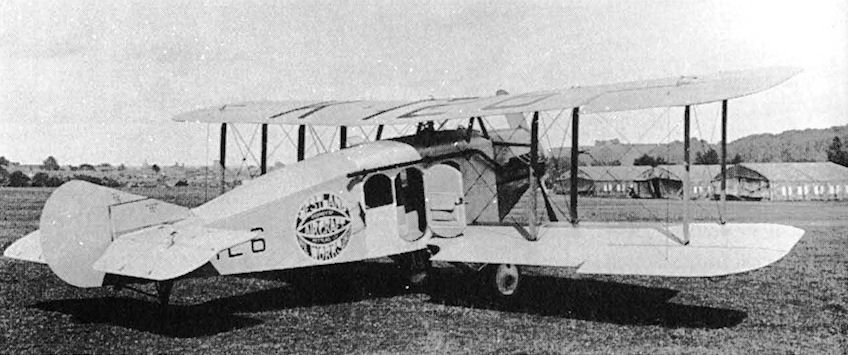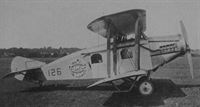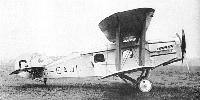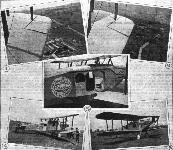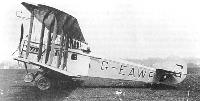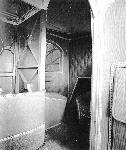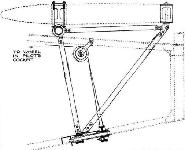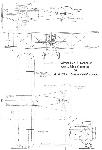D.James Westland aircraft since 1915 (Putnam)
Limousine
With the cessation of hostilities in November 1918, Arthur Davenport was already looking to the needs of postwar civil air services. Rather than attempt to produce Westland's first commercial aeroplane by modifying a proven military type, he struck out boldly with a completely new design with the declared intention of combining in a modern aeroplane all the best points of a high-class motor car with the principal advantage of an aeroplane: speed.
The outcome was the Limousine I, a single-engined two-bay biplane of wooden construction with fabric and wood covering. Although there were few, if any, new designs of engine available, Davenport chose the 275 hp Rolls-Royce Falcon III. This was a twelve-cylinder water-cooled vee engine - only the second of its configuration to be produced by Rolls-Royce - which had given high reliability service in several of the Bristol F.2B Fighter variants. Its installation in the Limousine I and II was reminiscent of that in the Fighter in that it also used the oval-fronted radiator employed in Bristol's renowned wartime two-seater.
The fuselage was built up in separate modules: a steel tube overhung-type engine mounting, the cabin section and the rear fuselage. The engine had metal cowling panels and was fitted with very long exhaust pipes which terminated more than half way along the fuselage to minimise exhaust noise in the cabin. The engine mounting structure was bolted directly to the cabin front bulkhead which had an asbestos layer between two multi-ply panels. This 'power egg' could be easily removed if an engine change was required or if an alternative type of engine was to be fitted.
To provide an unobstructed cabin the spruce and ash structure was covered with a three-ply skin which was reinforced around the door, the window and pilot's cockpit cut-out. In addition, the door, which was secured by an internal bar, had longitudinal reinforcing for additional rigidity. It was mounted on the starboard side, which had two windows, a single window being provided on the port side. A 50 gal fuel tank was carried immediately aft of the cabin front bulkhead. The rear fuselage was built up from a wood girder structure and was fabric-covered. It carried a fabric-covered tail unit, with small area vertical surfaces, of wood construction. To compensate for differing numbers and weights of passengers and their luggage, a tailplane trimming device was embodied in the design. The tailplane front spar was hinged to the top longerons and carried a hanging triangular frame inside the rear fuselage. The upper corners of the frame were attached to the two tailplane spars while the third lower corner was moved fore and aft in a rack and pinion type gear operated by a hand-wheel and Bowden cables from the pilot's position. The wings were of the traditional ash spars with spruce ribs and struts, the entire structure being internally wire-braced and fabric-covered. Ailerons of similar construction were carried on upper and lower wings and bumper bars were fitted below the two outboard pairs of interplane struts. A pair of spruce V undercarriage members carried a bungee-sprung through-axle and a tailskid was fitted.
The seating arrangement for the passengers and pilot certainly broke new ground. The pilot sat at the rear of cabin on the port side, his seat being raised 30 in above those of the passengers so that his head protruded through a hole in the cabin roof, a small windscreen being mounted in front of it. One wonders why Davenport placed the pilot behind the passengers. Was he influenced by a similar feature of the BAT FK.26, in which Fritz Koolhoven is reputed to have located the pilot as far aft in the fuselage as possible in order to give him the best chance of surviving a crash and thus being able to render an accurate and intelligent report on it? One passenger was seated on his lower right facing forward, a second immediately in front of him also facing forward, while the third passenger sat on the starboard side, facing aft, with a small folding table between him and the passenger behind. The reason for this seating configuration was that Davenport and Bruce saw the Limousine as an executive type aircraft in which meetings could take place and letters be dictated and typed ready for instant despatch when it landed. Thus, a secretary could fly, with her back to the engine, and a typewriter fixed to the table. It was later recorded that when the Limousine I prototype had become engaged in demonstration and sales flights, Westland's commercial manager. R J Norton, was 'ever ready to take up a secretary to demonstrate dictation in the air'.
The prototype, K-126 was completed and ready for its first flight by the end of July 1919, for which Stuart Keep was the pilot. During August, by which time the permanent civil registration G-EAFO had been allocated to this prototype, it went to the Aeroplane Experimental Establishment at Martlesham Heath for what were described as 'C of A performance trials' for the issue of its Certificate of Airworthiness on 21 August. Keep's initial reports indicated that there was some small amount of manageable longitudinal instability but that engine noise was low. This latter point was emphasised when passengers were carried, for a great deal of attention was paid to noise reduction in the cabin. The walls and roof were lined, the floor was carpeted and the luxurious grey, upholstered seats were thick and soft. All these and other measures helped to produce both a draught-free environment and noise level in flight no greater than that in a railway carriage. Flight reported Lady passengers may travel in this machine in the most delicate frocks without fear of getting them spoiled by oil'!
Production of a second airframe, the Limousine II, was completed in October 1919. Registered G-EAJL, it also had a 275 hp Falcon III but with a larger rectangular radiator and a redesigned fin and rudder of increased area. Demonstration and test flying continued during the ensuing six months and included a period at Martlesham Heath for evaluation of handling characteristics with the revised tail unit. Following a demonstration of the Limousine I at an air meeting organised by the Bournemouth Aviation Co at Winton racecourse on 1 May, 1920, this aircraft went to Croydon where G-EAJL was on loan to Air Post of Banks Ltd. From there both aircraft were used for experimental services to Paris, the fastest being recorded in September with a time of 1 hr 52 min. The chief pilot of this company was Frank T Courtney, a renowned freelance pilot but, like so many small aviation enterprises of its era. Air Post soon closed and both Limousines were returned to Westland.
Meanwhile a second Limousine II, G-EAMV, was built and was first flown in April 1920. It was intended as a test bed for the new 400 hp Cosmos Jupiter nine-cylinder radial engine designed by Roy Fedden and L F G Bunny' Butler. However, the Cosmos Engineering Co, based at Fishponds, Bristol, went into liquidation early in February 1920 and was not taken over by the Bristol Aeroplane Co until August. Thus it is surprising to find that the Limousine, rather than a Bristol aeroplane, was used for this work and, in the event, G-EAMV reverted to standard. A further three Limousine IIs were built, G-EARE, 'RF and 'RG, the first two, which had flown in October 1920, being leased to the new Instone Air Line, a company formed by the steamship-owning Einstein brothers, Samuel and Alfred, who had changed their name by deed poll. These two aircraft, fitted with 300 hp Hispano-Suiza 42 engines, flew regular Instone services on the routes to Brussels and Paris. In addition to a change of engine, the standard fuselage-mounted fuel tank, which was removed from its position aft of the engine where it was screened from the cabin by an asbestos-filled double-skinned wood bulkhead, was replaced by a streamlined external tank, under the port top wing, carrying 58 gal. The removal of the fuselage tank provided additional cabin volume making it even more spacious and luxurious. During 1922 Limousine IIs G-AEJL, 'MV and ‘RG were overhauled for their Certificate of Airworthiness renewal and were shipped to Newfoundland, the first two in July and the third in November, (see LimousineIII)
When the rules for the Commercial Aeroplane Competition, sponsored by the Air Ministry, were announced, they were such as to inspire Robert Bruce and Davenport to build a much larger six-passenger version, the Limousine III, powered by a 450 hp Napier Lion II engine. This was almost a new aircraft type having a 5 ft 6 in longer fuselage, three-bay wings increased in span by more than 16 ft, and a redesigned tail unit without a central fin, this being replaced by two small finlets on the tailplane. To meet the short-field landing reqirements of the Competition's rules, wheel brakes were fitted and twin nosewheels were mounted on struts attached to the bottom longerons and the undercarriage. These were to prevent the aircraft from going onto its nose if heavy braking was required during the short-landing trials. These involved landing over a 50 ft obstacle and coming to a stop within a circle marked on the ground. Sideslip landings were not permitted. As with the Hispano-Suiza-engined Limousine IIs, the fuel tanks were carried externally under the lower wings which reduced the fire-risk and permitted smoking in the cabin, where all seats faced forward.
The prototype Limousine III, G-EARV, construction of which was accelerated by using the rear fuselage of Limousine II G-EARH, work on which was abandoned, was first flown by Stuart Keep during June 1920 and made ready for the flight to Martlesham Heath for the Competition. Here, in August, with silver painted wings and an eau-de-Nile fuselage, the Limousine III won the ?7,500 first prize in the small commercial aircraft section, narrowly beating the Sopwith Antelope into second place on a technicality. When Harry Hawker, the Sopwith pilot, landed the Antelope in the trials, he did so with the brakes on, which burst both tyres of the main undercarriage, and one of the forward pair. The Antelope thus produced an unmatched short-distance landing, which was not officially recognised as the aircraft was not intact! However, it received second prize of ?3,000. Westland's victory in this section of the Competition, sadly, did not bring a rush of orders even though the Limousine III showed remarkable economy and stability - enabling Keep to leave his seat and join his passengers in flight - and was, undoubtedly, ahead of its time. Such was the state of the commercial aircraft market that only one more Limousine III was built, which was acquired by the Air Council in April 1921 having been allocated the serial J6851, but this was not taken up. Subsequently, it was loaned to Instone Air Line, registered G-EAWF, as part of a Government scheme for approved operators, where it became a reserve aircraft in company with the Limousine IIs G-EARE and ‘RF, until all three were withdrawn from service in 1923.
Having taken first place, G-EARV was used by Westland for some development flying until January 1921 when it was sold to FS Cotton's Aerial Survey Company and moved to Newfoundland in a pioneering role in fishery and seal spotting operations. Flown by T Ê Breakell it was fitted with both ski and wheel undercarriage and was later used in the Stag Bay gold rush. By the end of 1923 RV had logged a substantial number of flying hours carrying passengers, cargo and mail to remote communities. It was then acquired by Laurentide Air Service Ltd, with whom it was to have been registered G-CAET. However, upon arriving at Lac a la Tortue, Laurentide's maintainance base, for an overhaul and inspection, part of the Limousine's wooden structure was found to be rotted and it was scrapped in 1924.
Description: Three/five-seat commercial biplane. Wood construction with fabric and wood covering.
Accommodation: Pilot and three or five passengers.
Powerplant:
One 275 hp Rolls-Royce Falcon III twelve-cylinder water-cooled normally-aspirated vee engine driving a two-blade wooden propeller. (Limousine I and II).
One 300 hp Hispano-Suiza 42 eight-cylinder water-cooled normally-aspirated vee engine driving a two-blade wooden propeller (Limousine II).
One 410 hp Cosmos Jupiter III nine-cylinder air-cooled normally-aspirated radial engine driving a two-blade wooden propeller (Limousine II).
One 450 hp Napier Lion 1A twelve-cylinder water-cooled normally-aspirated geared broad-arrow engine driving a 7 ft 10 in four-blade wooden propeller (Limousine III).
Dimensions: Span 38 ft 2 in (Limousine I), 37 ft 9 in (Limousine II); length 27 ft 9 in; height 10 ft 9 in; wing area 440 sq ft (Limousine I and II). Span 54 ft 0 in; length 33 ft 6 in; height 12 ft 6 in; wing area 726 sq ft (Limousine III).
Weights: (Limousine I) (Limousine II) (Limousine III)
Empty 2,183 lb 2,010 lb 3,823 lb
Loaded 3,383 lb 3,800 lb 5,850 lb
Performance:
Maximum speed 100 mph 100 mph 118 mph
Cruising speed 85 mph 90 mph 90 mph
Sea level
climb 600 ft/min 650 ft/min 600 ft/min
Service ceiling 17,000 ft 17,000 ft 12,300 ft
Range 290 miles 400 miles 520 miles
Production: A total of eight Limousines was built by Westland Aircraft Works, Yeovil, Somerset, during 1919-21 as follows: One prototype Limousine I. Five Limousine II production aircraft. Two Limousine III production aircraft.
(The Limousine I's initial registration K-126 was carried in accordance with the provisions of the United Kingdom Air Navigation Regulations, which came into force on 20 April, 1919, requiring all British civil aircraft to carry registration markings. The International Air Navigation Convention did not come into force until 22 July, 1919, and, during the interim period, the Air Ministry introduced a system of temporary markings. It required all aircraft newly constructed or built from spares to be registered in a sequence beginning at K-100. A total of 175 such registrations were allocated during the system's short life, although K-169 was the highest K-number known to have been used. Thereafter British aircraft carried a four-letter registration group prefixed by the letter G).
Показать полностью
A.Jackson British Civil Aircraft since 1919 vol.3 (Putnam)
Westland Limousine
Designed by Arthur Davenport, the Limousine I was the Westland Aircraft Works’ first commercial aeroplane and one of the earliest attempts to introduce saloon car comfort into flying. It was a two bay biplane of conventional fabric-covered, wooden construction powered by one well-proven and economical 275 h.p. Rolls-Royce Falcon III, complete with Bristol Fighter type radiator. Situated amidships, the cabin was a plywood-covered structure for three passengers and pilot, the latter in the port rear seat, 30 in. higher than the passengers, with his head through a hole in the roof, open cockpit fashion. The prototype, K-126, first flown at Yeovil by chief test pilot Capt. A. S. Keep in July 1919, made a considerable number of publicity flights in 1919-20, including one during which Westland director R. J. Norton’s secretary typed letters to his dictation in flight.
October 1919 saw the completion of the Limousine II, G-EAJL, also with a 275 h.p. Rolls-Royce Falcon but externally identified by the rectangular radiator and increased fin and rudder area. The prototype, now registered G-EAFO, was demonstrated at the air meeting held at Winton Racecourse by the Bournemouth Aviation Company on 1 May 1920. Later, on 13 September 1920, it was leased, together with G-EAJL, to a new company known as Air Post of Banks Ltd. for an experimental Croydon - Le Bourget express mail service during which it made fastest time of the month by crossing in a time of 1 hour 52 minutes. The firm’s chief pilot was F. T. Courtney but after two months the Limousines returned to Yeovil where G-EAFO became the manufacturer’s communications aircraft. It gave useful service until struck and demolished by a Fairey Fawn on the ground at Netheravon in September 1925, while on a business visit, piloted by Major L. P. Openshaw.
A third Limousine, also Mk.II, had flown in April 1920 as test bed for the new 400 h.p. Cosmos Jupiter but later reverted to standard. It was followed by a small batch of four, two of which, ’RE and ’RF, flown in October 1920, were leased to Instone Air Line, flying regularly on the Paris and Brussels routes until purchased outright in June 1922. Limousine ’RE, which was fitted with a 300 h.p. Hispano-Suiza, set up a new London-Brussels time of 2 hours 8 minutes later in the year.
Publication of the rules for the 1920 Air Ministry Commercial Aeroplane Competition resulted in the construction of the Lion powered Limousine III, a much larger, three bay biplane for pilot and five passengers. It was fitted with wheel brakes and a nose wheel to permit their maximum use in the short landing test. Fuel tanks were fitted under the lower mainplanes to reduce fire risk and to allow smoking in the cabin, a feature also incorporated in the Instone Air Line Limousine IIs. Piloted at Martlesham by A. S. Keep, it just beat the Sopwith Antelope to win £7,500, first prize in the small commercial aeroplane section. An interesting sidelight was the presence of maker’s serial W.A.C.7 on the rear fuselage in contradiction of the aircraft’s documents, which quoted W.A.C.8. It is therefore probable that construction of the true W.A.C.7, the final Limousine II, G-EARH, was not completed. Although inherently stable and in advance of the time - Capt. Keep was able to leave the controls and join his passengers in the cabin - the market for commercial aeroplanes was non-existent due to the post-war slump, and only one other Limousine was built. This was a Mk.III supplied to the Air Council in April 1921 under a Contract placed on 11 November 1920 and was to have appeared in R.A.F. markings as J6851 but was registered G-EAWF instead and joined the small fleet of miscellaneous transports on loan to approved firms under the Government’s subsidy scheme. It thus became the Instone Air Line reserve aircraft, joining its smaller brethren ’RE and ’RF at Croydon until all three were pensioned off in 1923.
Competition winner G-EARV pioneered air transport in Newfoundland with the Aerial Survey Company (Newfoundland) Ltd. formed in November 1920 by Maj. F. S. Cotton, A. S. Butler and Capt. S. Bennett. Successful, if difficult, seal and fishery spotting on wheels and skis in January 1921 was followed by a long charter flight to Cartwright, Labrador, piloted by T. K. Breakell during the gold rush. In July 1922 the Limousine Ils G-EAJL and ’MV were overhauled for C. of A. renewal and then also shipped to Newfoundland, followed in November by G-EARG.
The company operated in Newfoundland until the end of 1923, carrying mail and passengers between remote outposts. The large Limousine III G-EARV was then purchased by Laurentide Air Service Ltd. for $5,000 and registration G-CAET was reserved but on arrival at the company’s maintenance base at Lac a la Tortue near Grand’Mere, Quebec, the aircraft was condemned and scrapped because of rot in the wooden structure.
SPECIFICATION
Manufacturers:
The Westland Aircraft Works, Yeovil, Somerset.
Power Plants:
(Limousine I and II)
One 275 Rolls-Royce Falcon III.
(Limousine II)
One 300 h.p. Hispano-Suiza.
One 410 h.p. Cosmos Jupiter III.
(Limousine III)
One 450 h.p. Napier Lion.
Limousine I Limousine II Limousine III
Span 38 ft. 2 in. 37 ft. 9 in. 54 ft. 0 in.
Length 27 ft. 9 in. 27 ft. 9 in. 33 ft. 6 in.
Height 10 ft. 9 in. 10 ft. 9 in. 12 ft. 6 in.
Wing area 440 sq. ft. 440 sq. ft. 726 sq. ft.
Tare weight 2,183 lb. 2,010 lb. 3,823 lb.
All-up weight 3,383 lb. 3,800 lb. 5,850 lb.
Maximum speed 100 m.p.h. 100 m.p.h. 118 m.p.h.
Cruising speed 85 m.p.h. 90 m.p.h. 90 m.p.h.
Initial climb 600 ft./min. 650 ft./min. —
Ceiling 17,000 ft. 17,000 ft. 12,300 ft.
Range 290 miles 400 miles 520 miles
Production:
One Limousine I: (W.A.C.l) K-126/G-EAFO.
Five Limousine II: (W.A.C.2) G-EAJL; (W.A.C.3) G-EAMV; (W.A.C.4) G-EARE; (W.A.C.5) G-EARF; (W.A.C.6) G-EARG.
Two Limousine III: (W.A.C.8) G-EARV; (W.A.C.9) J6851/G-EAWF.
Note: (W.A.C.7) Limousine II G-EARH not completed.
Показать полностью
Журнал Flight
Flight, August 7, 1919.
"WESTLANDS" OF YEOVIL
YEOVIL, before the War, was chiefly associated in the minds of most people with the manufacture of oil engines, the name Petters being a household word in this connection. During the War Yeovil has become known for something besides oil engines - still in connection with the old name of Petters it might be pointed out. Always alive to the possibilities of the times, those responsible for the management of Petters, Ltd., foresaw, quite early in the War, that there would be a great demand for aircraft, and consequently an aircraft branch was founded, with a separate management, but on which Mr. P. W. Petter and Mr. R. A. Bruce were joint directors. The aircraft branch of Petters, Ltd., became known as the Westland Aircraft Works, and for a start machines were constructed to other people's designs. However, it was not very long before it was decided to produce original machines, for the design of which Mr. A. Davenport became responsible, and two types which resulted will be familiar to most people in touch with the aviation industry, the "Wagtail" and the "Weasel." Nor are these two the only types which have emanated from the Westland Aircraft Works, although they are, perhaps, those best known.
Last week we had, in company with representatives of the technical press, an opportunity of inspecting the Westland works at Yeovil, and to see the new commercial aeroplane which has been designed and built since the Armistice. The party was met at Paddington station by Lieut.-Col. Meares, who is now associated with the London end of the firm. On arrival the visitors were introduced to Mr. R. J. Norton, commercial manager of the firm, and to Mr. F. Chandler, who is works manager. The party, which also included Capt. A. S. Keep, M.C., late R.A.F., having by motor reached the works and aerodrome, a tour of the works revealed the fact that a great factory has been built during the War, in which the most up-to-date machinery is running at full pressure, producing, among other machines, Vickers-Vimy bombers, of which a large order is being completed. One also noted several Airco (de H.) biplanes, while the large and well-organised drawing-office was busy with the designs for several post-War commercial machines, one of which is already in production, the first machine of the batch being in flying trim on the day of the visit. This machine, which is known as the Westland "Limousine," has been designed to combine the qualities of a luxurious motor and a yacht. As the accompanying illustrations will show, the "Limousine" has a totally enclosed cabin, with seating accommodation for pilot and three passengers. The pilot occupies the rear port seat, which is raised above the floor of the cabin so as to bring his head above the roof, in which there is a cockpit for the pilot, whose head is protected from the wind by a screen. One of the passengers sits next to the pilot, but a little lower so as to be right inside the cabin. The two remaining seats are placed near the front wall of the cabin, the occupant of the port seat facing forward, the other passenger sitting with his back to the cabin wall. This object of this placing was not clear at first, but was explained when Mr. Norton took his seat in the machine, the other front seat being occupied by a shorthand typist, who calmly placed her typewriter on a little hinged table attached to the front wall of the cabin. The writer of these notes was requested to take the remaining seat so as to be in a position to testify that a message was dictated by Mr. Norton during the trip, was first taken down in shorthand, and was then transcribed on the typewriter. When Capt. Keep had taken his seat the party was complete, the chocks under the wheels were taken away, and the machine commenced to taxy along the ground. When the far side of the aerodrome had been reached the pilot swung the machine around into the wind, and opened the throttle. The Rolls-Royce Falcon commenced its roar - at least one presumes it did, since inside the cabin the noise was no more than that of an engine running well throttled down, and in a few seconds we were in the air. But what a difference to the ordinary open aeroplane. There was no more noise than in a railway carriage, and as for draught, there simply wasn't any. At the same time the ventilators in the roof prevented the air from getting at all stuffy. There we sat, as comfortable as if we had been at rest on the ground, and yet we were travelling along at over a hundred miles per hour. Mr. Norton's voice could be heard as he dictated his letters, while below a lovely panorama was unrolled, the beauty of which one could enjoy undisturbed by any rush of wind or by any unpleasant noise. The day was hot, and consequently there was a number of heat bumps; but for the latter one had little sensation of movement. As we climbed higher the bumps grew less, and finally appeared practically to cease. By now Mr. Norton had finished his dictation, and the typist commenced to transcribe. As it happened, however, that particular letter was not destined to be typed in the air, for the typewriter had been so fixed that while it worked quite well where small letters were concerned, it was too close against the upholstery on the cabin wall to permit of writing caps. As Mr. Norton refused to have the letter written entirely in the lower case he called to the pilot to descend. After a short glide we landed without incident. The writer of these notes was quite satisfied as to the cause of the difficulty and would willingly testify to the practicability of both dictating and typing during flight, but Mr. Norton insisted upon having the matter put right, and in a subsequent flight, when the typewriter had been moved out from the wall, the experiment was repeated and succeeded without any hitch.
It will, therefore, be seen that in the Westland limousine one has a machine in which it will be quite feasible for a Cabinet Minister, or the head of a large commercial undertaking, or anybody else whose time is valuable, to travel from one place to another, faster than is possible by any other means, while at the same time doing it in greater comfort. Further to save time it will be possible for the owner of such a machine to dictate correspondence and to have it typed out en route, ready for posting as soon as the machine reaches its destination.
That it will be more expensive than going by train may be granted, but to the busy man, whose time is worth a lot of money, the saving in time which the aeroplane can effect will more than compensate for the extra cost.
It is not, however, to the business man only that a machine like the Westland limousine will appeal. The wealthy man on pleasure bent could not wish for a more comfortable, nor for a more entertaining way of touring either at home or abroad (when the authorities open the barrier to international flying). There is no doubt that once the charms of flying in the modern comfortable aeroplane are realised by those whose means of transport or for pleasure - and it would be idle to pretend that it is at present within the reach of the poor - this mode of travel will become increasingly popular. The three old-time enemies of comfortable air travel - noise, wind and oil - are absent in the modern limousine of the air, and when this fact has once been well established we shall soon see great numbers of these machines in frequent use by their private owners.
After a number of joy-rides had been made by the visitors, the party was taken to tea, when Mr. P. W. Petter, in a few brief words, outlined the policy of the Westland Aircraft Works. The firm, it is gratifying to learn, intends to remain in the aviation industry, those responsible for its management being firm believers in the future of aviation, and being ready to face the difficult times which the industry will have to pass through before flying comes into its own. We should have liked to have given this week a more detailed description of the Westland limousine, but space calls a halt, and we hope to record the fuller description in next week's issue.
Flight, August 28, 1919.
THE WESTLAND LIMOUSINE
AN account of a trip to Yeovil to inspect the Westland Aircraft Works was published in our issue of August 7, 1919. This referred briefly to the new passenger or mail carrier produced by this firm. At the time it was not possible, from considerations of space, to include a lengthy description of the Westland limousine, and we are therefore now giving a more detailed description of it in the present issue. In one respect the first article requires modification, in that the impression was conveyed that the machine was designed by Mr. Davenport. Actually the designer of the limousine, as of all the Westland aircraft, is Mr. R. A. Bruce, who is the head of the Westland Aircraft Works, and with Mr. P. W. Petter, joint managing-director of Messrs. Petters, Ltd. Mr. Bruce is, however, ably assisted by Mr. A. Davenport, chief draughtsman of the Westland Aircraft Works.
The Westland limousine, which has been designed and built since the Armistice, is intended to provide for the man of means, to whom time, is of great value, a fast and at the same time comfortable means of locomotion. The object kept in mind by the designers was to combine in a modern aeroplane the best points of a high-class motor car and at the same time possessing the initial advantage of the aeroplane - speed. That this object has been attained cannot be denied. The Westland limousine is extremely comfortable to fly in, sheltered as the passengers are from the rush of wind which makes for discomfort in an open machine. It approximates very closely to the motor car, in that it is designed to carry three passengers in addition to the pilot; and while its engine - a 275 h.p. Rolls-Royce "Falcon" - is not of so high a power as to raise running expenses to an exorbitant point, it is nevertheless of sufficient power to give the machine a very good performance, both as regards speed, climb and endurance. That running expenses will be higher than those of a four-seated motor car must be admitted, but then it should be realised that the aeroplane will do cross-country journeys very much faster than any motor. Also it is actually a fact that there is less vibration and jolting than in a motor going over any but the smoothest of roads, and consequently it is possible for the owner of such a machine to carry on work en route which he could not do with any comfort in a motor car. Thus it is quite easy and comfortable to write or read while the machine is in the air, and Mr. Norton, Commercial Manager of the Westland Aircraft Works, demonstrated on our recent visit to Yeovil that it is quite possible to take up a shorthand typist and to dictate and have typed out letters while the machine is in flight. The time spent on a journey, in addition to being very much shortened by travelling by air, instead of being wasted can be employed for getting through urgent correspondence or other work, and to have such correspondence ready for posting the instant the machine reaches its destination.
Fundamentally the Westland limousine is an ordinary single-engine tractor biplane, with its body made slightly deeper and wider than that of the usual open type of machine. As will be seen from the illustrations, this has been accomplished without spoiling the lines of the machine, which, as a matter of fact, are very pleasing to the eye.
As regards structural design, the Westland limousine is interesting in several respects. For instance, the unit type of design, which has several marked advantages, has been followed to a considerable extent. Thus the fuselage comprises three separate units. The first is the engine mounting and housing, which forms a unit separate from the next one - the cabin. The structure which carries the engine is of the overhung type, and is constructed mainly of steel tubing. This unit is bolted to the cabin unit and is readily removable, should it be desired to change the engine. This system of construction has several advantages. For instance, if it is desired to overhaul the engine it is a simple matter to remove the entire power plant to the engineers' shop, where the work can be most efficiently done. Or, in case of a firm running a passenger or mail service with these machines, if an engine needs overhaul the whole front unit of a machine may be taken out and a new one substituted in a short time, thereby avoiding a long delay before that particular machine can be put into service again. Also, the substitution of one type of engine for another is greatly simplified by the unit system.
Perhaps the most interesting feature of the Westland limousine is the arrangement of the cabin. In order to provide a clearer space inside, the central unit of the fuselage has been constructed on a different principle, which does away with any internal bracing. Without going into minute details of the actual construction, it may be said that in principle it consists in covering the sides of the body with ply-wood, stiffened with a framework of diagonal members. Where door and windows occur, bent frames are provided which more than make up for the weakening that might otherwise attend the cutting of the side covering. Thus the door giving entrance to the cabin is placed on the starboard side, and to make up for the absence of side bracing of the fuselage at this point there are curved frames above and below the door which take the place of the ordinary bracing. The added comfort of having the door in the side will be apparent, as the cabin is entered as easily as is the ordinary motor car.
As indicated in the plan view of the general arrangement drawings, the seats of the Westland limousine are arranged in a somewhat unusual fashion. Against the front wall of the cabin, on the starboard side, is one seat facing aft, while the corresponding seat on the port side is placed slightly farther aft and faces forward. In front of the latter seat is a neat little folding table, which may be used for writing, accommodating if desired a typewriter. Of the remaining two seats, both of which face forward, the pilot occupies that on the port side, the starboard one being available for a third passenger. The pilot's seat is raised about a foot off the floor of the cabin so as to bring him into a position with his head projecting through an opening in the roof of the cabin. From here the pilot obtains a very good view, certainly no worse than that obtained in the ordinary tractor biplane, and better than some we have seen. As already mentioned, the entrance door is on the starboard side, and is so arranged that when in flight it is locked by a bar that precludes any possibility of the accidental opening of the door. On the starboard side there are two windows, one for each of the passengers sitting on this side, while the third passenger looks out through a window to port. In the roof of the cabin is a ventilator, adjustable from the inside, which admits air to the cabin and prevents any tendency to stuffiness. The noise of the engine is very effectively silenced, partly by the long exhaust pipes, and partly by the fact that the machine is enclosed. What adds considerably to the silence is the provision of an asbestos bulkhead at the front of the cabin. The ordinary three-ply partition would probably act as a very efficient sounding-box and tend to increase rather than decrease the noise.
The seats are upholstered in grey, and the whole cabin is most comfortable and pleasing in appearance, while the occupants are so well protected from oil and dirt of any kind that no special flying rig is required. Lady passengers may travel in this machine in the most delicate frocks without fear of getting them spoiled by oil.
The rear portion of the fuselage is of the usual wood girder wire braced type, and does not call for any special comment. In order to compensate for the difference in weight or number of passengers carried, the Westland Limousine is provided with a tail plane trimming gear. This in itself is not, of course, a novel feature, but the design of the trimming gear itself is somewhat unusual and is, we understand, protected by a patent. As will be seen from the accompanying diagram, the tail plane hinges about its front spar and has its incidence changed by shifting the lower angles of two triangles, formed by steel tubes. The diagram is, we think, self-explanatory. When the worm is rotated in one direction, via cables and pulleys, the lower point of the triangle moves forward, dropping the rear spar of the tail plane and thus increasing the angle of incidence. When the pilot rotates the wheel in his cockpit in the opposite direction, the incidence is decreased.
From the specification printed below, it will be seen that the Westland Limousine has a very good performance, and from a careful watching of the pilot's movements during a recent flight we are convinced that the machine needs very little control during a straightforward flight, while at the same time, when it is desired to manoeuvre her quickly she answers very readily and appears quite light on the controls. The following specification gives all the more important data relating to the machine:-
Length overall, 28 ft. 6 ins.; span, 38 ft. 2 ins.; height, 11 ft.; total wing area, 440 sq. ft.; weight empty, 2,183 lbs.; weight fully loaded, 3,383 lbs.; fuel capacity, 3 hours; range, 290 miles; commercial load, 540 lbs.; passenger or cargo space, 95 cubic ft.; Speed, ground level, 100 m.p.h.; at 10,000 ft. 91 m.p.h.; at 15,000 ft. 85 m.p.h. Climb, to 5,000 ft. in 8-35 mins.; to 10,000 ft. in 19.6 mins.; to 15,000 ft. in 37.5 mins; ceiling, 17,000 ft. Landing speed, 50 m.p.h. ; load/sq. ft., 7.8 lbs.; load/h.p., 15.1 lbs. Engine, 275 h.p., Rolls-Royce Falcon. Cruising speed, 85 m.p.h. at 1,750 r.p.m.
Flight, December 18, 1919.
THE PARIS AERO SHOW 1919
PRELIMINARY REPORT ON BRITISH SECTION
The Westland Aircraft Works
This firm is showing on stand No. 20 a complete Westland limousine, similar to the standard machine which has been described in FLIGHT. The colour scheme is grey and aluminium throughout. The wings and rear portion of the fuselage are grey, while the cabin is aluminium. The upholstery is grey Bedford cord. Generally speaking, the exhibition machine is similar to the standard. It might be mentioned that an altimeter and speed indicator are fitted in the cabin, where they can be read by the passengers. In addition to the complete machine, Westlands will show one side of a cabin, showing the construction, which, it may be remembered, is of the unit type, the engine compartment forming one unit, the cabin another, and the rear portion of the fuselage a third. A scale model will be shown of the limousine fitted up for mail carrying.
In addition to the machine at the exhibition there will be a demonstration machine at the Le Bourget aerodrome. This machine has been in service since last July, and has done a great deal of flying, including mail carrying during the railway strike. It will, therefore, form a good opportunity for prospective purchasers to see how the Westland limousine stands up to hard wear. The machine will be fitted with hot water heating apparatus, which can be regulated by the passengers.
Both machines will be flown across from Yeovil to Paris, and it is hoped that all the material required for the stand, etc., may be carried on board the two machines, thus avoiding the necessity for any other form of transport.
The overall length of the Westland limousine is 28 ft. 6 ins. and the span is 38 ft. 2 ins. The maximum speed, fitted with 275 h.p. Rolls-Royce Falcon engines, is 115 m.p.h. a t 1,000 ft., and the cruising speed is 85/90 m.p.h. With full load of pilot and three passengers the machine will climb the first 1,000 ft. in one minute, which is sufficient for clearing obstacles around the aerodrome on taking-off.
Показать полностью
